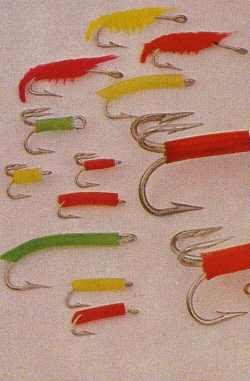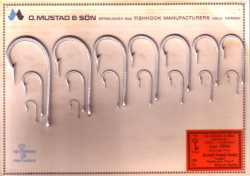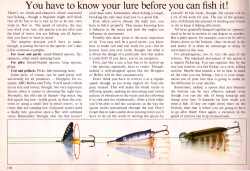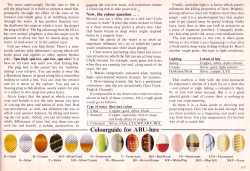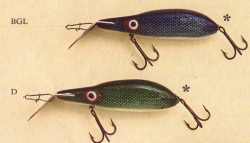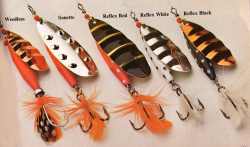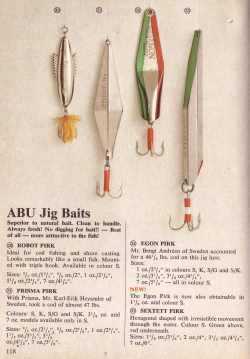ABU Angling : Lures V Baits
We anglers DO NOT catch fish by employing poison, explosives, spear guns, hand spears, tickling, draining a dam, employing nets or stream-flow traps to assist in making the process less challenging.
At least ABU anglers do not!
ABU sold their own luminous hooks and according to ex-owner Len Borgstrom, were supplied on lures and as after market products. The intention was to use them bare as well as baited.
It is strange that ABU never sold the fancy live bait rigs popular in UK and USA to catch predatory fish like pike . We Aussies just put a single hook through the bait fish's lips or if under a float, the hook went above the backbone and toward the back.
ABU therefore recognized that despite producing a brilliant range of artificial baits viz spoons, plus, perks, flies and spinners, hooks and bait-fishing were still very much part of their customer's sphere of interest.
Old fishers, before Sport-fishing and Catch and Release concepts were common, will maybe reluctantly admit more fish are often caught using bait rather than lures! I believe this to be true in some circumstances. I don't always use bait due to this successfulness. The berley effect alone WILL bring fish to where one is fishing. Sometimes I will start fishing with a live bait or a dead one if none available , along with an attractive berley trail before I start luring. Obviously berley is only suitable to be employed where a boat is at anchor or one is fishing from a fixed beat on a river bank where the trail can be observed and fished in.
It is interesting that many controlled angling venues ban the use of bait for fishing and some even prohibit the use of spinning lures and are fly-fishing only. This must surely tell us something about the relative effectiveness of the various techniques.
Angling is not about Max Kill or selling fish for profit or even as some might justify to themselves "To cover my costs" . If you are supposedly an amateur, you should not need to have to pay for the fuel or indeed the boat and motor, just do it and enjoy your sport.
Many anglers (and their families) will like to bring home the bacon so to speak and provide a fresh fish meal for the household and some will like a few fish fillets on hand in the freezer. All acceptable results for fair sports fishing I think. Challenging ourselves and getting out of our comfort zones enable us to learn.
As this occurs, many often get more adventurous and experiment with techniques they are less familiar with such as fly fishing or luring. For me, the new is Fly fishing, not so successful yet but nice to try. Hey the meal is provided for the family, let's take a risk and and try some new lure or technique. Failure this time won't matter! Get away from the frozen, pre-packaged shop bought bait. The pinnacle of achievement must surely be catching our own live bait, keeping it alive, rigging it and placing it such that a fish is fooled or using a lure or fly that we have crafted with our own hands or merely correctly selecting one of a multitude in our tackle box which worked on the day.
If you have young children , they just love to help catch live bait too and it is an educational process whereby species are identified and conservation opportunites pop up with returning unwanted bait back to the water live. Take Kid Fishing!
I have some fishing mates who will only use lures, primarily for the challenge, but personally, I employ both bait and lure techniques. Sometimes the bait is absent and one is forced into used lures.
Having outlined some of the advantages of bait, further discussion of lures is needed to encourage newbies to give them a go. Education is needed here as in any pursuit to be learned, and we must get beyond the 'Chuck it and chance it' with little observation. records should be keep of your own experiences, ie tide, water levels in impoundments, wind, sunlight, rain, presence of birds/bait schools, success/failure of other fishers nearby. These are invaluable and can be referred back to , in order to learn.
So with Lures,
1. An immediate start to fishing is possible. No bait gathering phase. More time casting has to be an advantage.
2. Main task is selecting the right lure for the particular circumstances and decide how long to persist until a change is made.
3. Lures cover more territory in 3 dimentions than any bait can.
4. Few conditions are imposed upon us, as with the collecting and use of particular live baits in certain areas.
5. No mess preparing cut baits or organizing aeriators and live bait boxes
6. Generally lures are cheaper than expensive tackle-shop bought bait on a weekly basis. Work out the cost of herring/shrimp and you will find it approximates or eclipses the cost of seafood you buy to eat! Once a good selection of lures that work has been amassed , little other cost is accrued except of course buying more and sadly it can be a habit for some and lots of money is spent. They say many colourful lures catch more fisherman by the wallet, rather than fish caught on the said lure!
7. A much steeper learning curve is experienced, though the method by which one learns is largely experimental and enjoyable.

The primary factors one concentrates upon when using lures are retrieval techniques, though also conditional is ability to cast different weight lures according to wind conditions and /or the amount of cover where casting. Specialized forms of lure casting have developed to get lure under overhanging branches such as side casting and flick casting which employed the inherent flexibility of the rod to propel the lure into difficult positions when the lure was released under tension by the hand.
Standard deep diving wobblers like all plugs fitted with a bib, eg the Cello Dipp have a maximum depth they will descend to to when retrieving. If a floating model, one can employ the stop winding approach and it will rise to the surface. Sinkers of course will descend to the floor of the seabed or stream. The Hilo covered in detailed Lure Study is the most adjustable (and popular) lure from popper on the surface to deep diver. Floaters naturally help when an overcast is made or being released from a snag.
Retrieval varies with the type of lure being used and may range from high speed such as when "popping" cup-faced surface lures like the ABU Cello across the water surface .
Spinning can be constant rewind , high speed or med/slow speed or stop and start fallback in the mid water column or bottom bouncing to disturb sediment and attract fish.
Heavy water perks were
dropped to the bottom and jigged up and down in various strata of water
according to where the sonar suggested fish were holding. 
The same vertical procedure was used in ice fishing with tiny ice fishing perks. No sonar of course. No fish, drill another ice -hole! (says one who has never done it!)

Then we have fly casting which may range from upstream dry fly techniques or down stream subsurface retrieval with wet flies. A technique called "dapping" with dry flies originated from Ireland where a long pole allowed the fly to be lifted and carried by the wind to land on lake water simulating reality.
Lures can be trolled behind a boat at different depths by using a down rigger to place the lure where fish are seen by sonar.
Lures need not necessarily look like the bait the quarry fish normally eat. Matching the hatch or lure selection according to bait around can be still very effective. So many factors come into what entices a strike. The lure's turbulence in the water, position, speed, action and reflectivity are just some of the variables involved. All of these things can cause a fish to strike because of aggression, territorial nature or just plain curiosity.
Recently, when fishing by wading in a local estuary, I noticed small herring-like fish splashing en mass on the outgoing stream surface. Closer observation showed masses of tiny prawns only 10/15mm long being eaten by these herring. The mass splashing by hundreds of these herring naturally has attracted interest by larger predators swirling amongst them. I quickly selected a small silver Toby 7g and cast it in the action. After several casts I was rewarded with a 65cm Queenfish, and soon after a 55 cm Silver Trevally and before I finished a 50 cm Flathead which goes to show bait action attracts all sorts of species to the fray. An exciting 15 minutes. When the bait moved on so did the bigger fish. I am sure I could not have caught these fish any other way than the lure which exactly matched the baitfish which were unavailable to me.
So, in short, use what techniques you will, be they bait or lure, but above all use your head and particularly your eyes to help guide your choice of what, where, when to use and DO Persist!
Tight Lines
Wayne
As time permits more details of these techniques will be considered. Please feel free to contribute your ABU lure experiences if you have specialized knowledge...
Using Jigging Lures
Using Wobbling Lures
Using Trolling Lures
Using Flies/Lures
If you have any other lures, that are un-needed or doubles in your collection and are available for swapping or a reasonable fee, I would be very pleased to hear from you.
